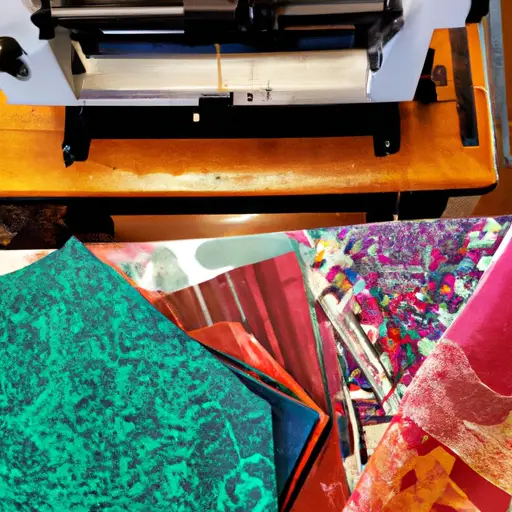Textiles have always played a crucial role in our lives, from the clothes we wear to the fabrics that adorn our homes. If you have a subconscious desire for innovation and want to level up your textiles, then DIY screen printing and block printing techniques are the perfect avenues to explore.
These techniques not only allow you to unleash your creativity but also give you the power to add a personal touch to your fabrics.
Screen printing is a versatile technique that involves transferring ink through a mesh screen onto fabric, creating crisp and vibrant designs. It allows you to experiment with various colors, patterns, and textures, giving your textiles a unique and professional look.
On the other hand, block printing involves carving a design onto a block of wood or linoleum and then transferring the image onto fabric by pressing the block onto the surface. This technique offers a more hands-on and organic approach, allowing you to create intricate and detailed designs.
Whether you choose screen printing or block printing, mastering these techniques will enable you to take your textiles to the next level and open up a world of possibilities for your creative endeavors.
Getting Started with Screen Printing
To begin the process of screen printing, one must first gather the necessary materials and equipment. These include a screen, a squeegee, ink, stencil or design, and a printing surface such as fabric or paper.
The screen is the most crucial component as it holds the stencil or design in place and allows ink to pass through onto the printing surface. Screens can be made of various materials such as polyester or nylon, and they come in different mesh sizes depending on the desired level of detail in the print.
The squeegee is used to push the ink through the screen, ensuring even distribution and coverage. Inks come in a wide range of colors and consistencies, and it is important to choose the appropriate ink for the printing surface.
Finally, the stencil or design can be created using various methods such as hand-drawing, digital printing, or using photo emulsion techniques. Once all the materials are gathered, the screen can be prepared by applying the stencil or design onto it, ensuring it is securely attached and properly aligned.
Screen printing offers endless possibilities for creative expression and innovation. The process allows for vibrant and detailed prints with a professional finish. By using different colors, textures, and techniques, one can create unique and eye-catching designs that stand out.
Not only is screen printing versatile, but it is also a cost-effective method of printing in bulk, making it an ideal choice for artists, designers, and entrepreneurs. Additionally, screen printing can be used on various materials such as fabric, paper, glass, or even metal, expanding its applications beyond traditional mediums.
With its ability to produce high-quality prints and its versatility, screen printing is an excellent choice for those looking to level up their textile creations and unleash their creativity.
Mastering the Art of Block Printing
Mastering the art of block printing involves honing one’s skills in creating intricate designs using carved blocks and achieving consistent and precise impressions on various textile surfaces.
Block printing is a traditional technique that has been used for centuries in different cultures around the world. It requires patience, attention to detail, and a deep understanding of the materials and tools involved.
To create a block print, an artist starts by carving a design into a block of wood or linoleum. The design can be simple or complex, but it must be carefully planned and executed to ensure that it will transfer onto the fabric accurately.
Once the block is carved, ink or paint is applied to the raised surface of the block using a brayer or roller. The block is then pressed firmly onto the fabric, transferring the ink or paint and creating an impression of the design. This process is repeated multiple times to create a pattern or a larger image.
Achieving consistent and precise impressions in block printing requires practice and skill. The pressure applied when pressing the block onto the fabric must be even to avoid smudging or uneven distribution of ink. The artist must also pay attention to the amount of ink or paint applied to the block, as too much or too little can affect the clarity and definition of the print.
Additionally, the choice of fabric and its preparation can impact the final result. Different fabrics absorb ink differently, so it is important to experiment and test before starting a larger project.
Mastering the art of block printing allows artists to create unique and intricate designs on various textile surfaces. It is a technique that combines creativity, precision, and craftsmanship. With practice and experimentation, artists can push the boundaries of block printing, creating innovative and captivating designs that showcase their skills and passion for this ancient art form.
Choosing the Right Materials and Tools
The selection of appropriate materials and tools holds significant importance in the process of achieving consistent and precise impressions in block printing.
When it comes to materials, it is essential to choose a block that is made of a durable and smooth material, such as linoleum or wood. These materials provide a stable surface for carving the design and ensure that the block will last for multiple printings.
Additionally, the choice of ink is crucial in achieving vibrant and long-lasting prints. Water-based inks are commonly used in block printing due to their ease of use and ability to produce rich colors. However, oil-based inks are also an option for those who prefer a more traditional look.
In terms of tools, a variety of carving tools are available for block printing, each with its own purpose. V-shaped gouges are used for carving lines and details, while U-shaped gouges are ideal for removing larger areas of the block. It is essential to have a selection of different sizes and shapes to achieve the desired effect in the design.
Additionally, a brayer or roller is necessary for evenly applying ink to the block. Choosing a brayer with a firm and smooth surface ensures that the ink is distributed evenly, resulting in consistent prints.
Lastly, a barren or a printing press is required for transferring the ink from the block to the paper. A barren is a handheld tool that requires manual pressure, while a printing press applies pressure mechanically. The choice depends on personal preference and the desired level of control in the printing process.
By carefully selecting the right materials and tools, block printers can achieve precise and captivating prints that showcase their artistic vision.
Exploring Advanced Techniques and Designs
Exploring advanced techniques and designs in block printing opens up a world of creative possibilities, allowing artists to push the boundaries of their artistic expression and create unique and intricate patterns that captivate the viewer.
With the use of different carving techniques, artists can achieve varying levels of depth and detail in their designs. By experimenting with different carving tools and techniques, artists can create prints with a range of textures and visual effects, from bold and graphic to delicate and nuanced.
In addition to carving techniques, artists can also explore different methods of applying ink to the block. By using different brushes, rollers, or even their hands, artists can create prints with varying levels of ink coverage and texture. This allows for a greater range of expression and experimentation, resulting in prints that are truly one-of-a-kind.
Furthermore, artists can also experiment with layering and overlapping different colors of ink to create vibrant and dynamic prints. By carefully planning and strategically layering the colors, artists can create prints that have depth and dimension, giving the illusion of multiple layers and textures.
These advanced techniques and designs in block printing not only allow artists to elevate their craft, but also inspire innovation and creativity in the field of textile design.
Conclusion
Screen printing and block printing are two versatile techniques that allow you to level up your textile creations. Whether you are a beginner or a seasoned artist, these methods offer endless possibilities for creating unique and eye-catching designs on fabrics.
In screen printing, you use a stencil to transfer ink onto your chosen fabric. This technique provides precise and consistent results, making it perfect for creating intricate patterns and detailed designs. By mastering the art of screen printing, you can effortlessly reproduce your designs on various textiles, such as t-shirts, tote bags, and even home decor items.
On the other hand, block printing involves carving a design onto a block and then stamping it onto fabric. This technique offers a more hands-on and organic approach to printing, allowing you to create one-of-a-kind prints with a beautiful handmade feel. With block printing, you have the freedom to experiment with different materials, such as linoleum or wood, and create unique textures and effects on your textiles.
When it comes to choosing the right materials and tools for your printing projects, it is essential to consider the type of fabric you will be working with. Different fabrics require different types of inks and printing screens or blocks. Additionally, investing in high-quality tools, such as sharp carving tools for block printing or durable screens for screen printing, will ensure better results and longevity in your creations.
Once you have mastered the basics of screen printing and block printing, you can start exploring more advanced techniques and designs. This could include experimenting with multiple colors, layering different stencils or blocks, or even combining screen printing and block printing to create unique and dynamic prints. The possibilities are endless, and the only limit is your creativity.
In conclusion, screen printing and block printing are exciting techniques that can take your textile creations to the next level. Whether you prefer the precision and consistency of screen printing or the hands-on and organic feel of block printing, both methods offer endless possibilities for creating unique and eye-catching designs on fabrics. By choosing the right materials and tools and exploring advanced techniques, you can unlock your creativity and create stunning prints that are sure to impress. So, why not give screen printing and block printing a try and see where your artistic journey takes you?
 printablelabelstemplate
printablelabelstemplate
